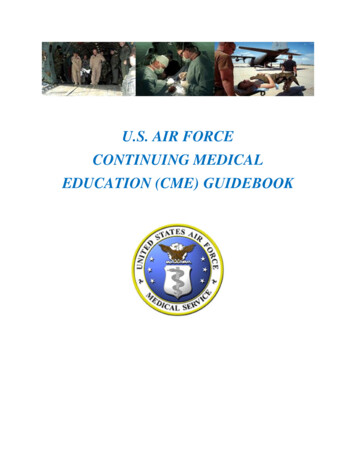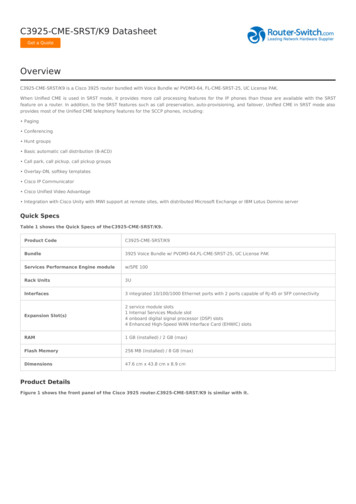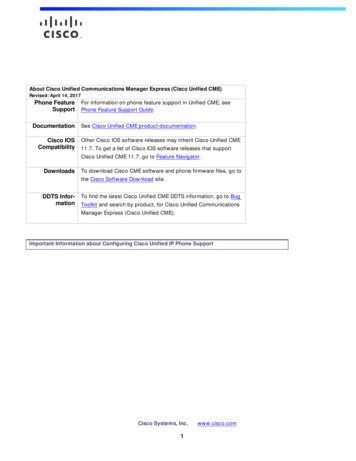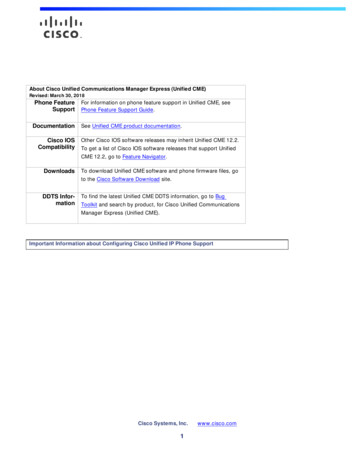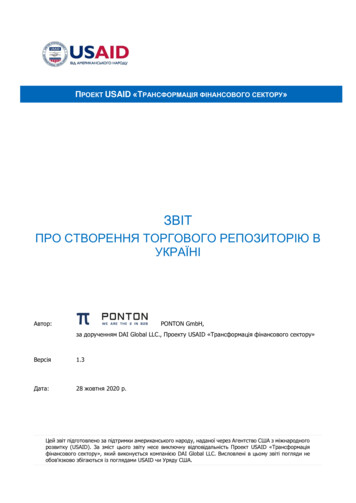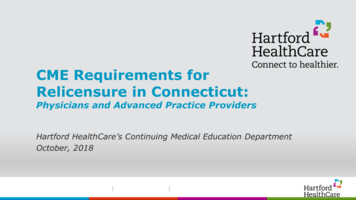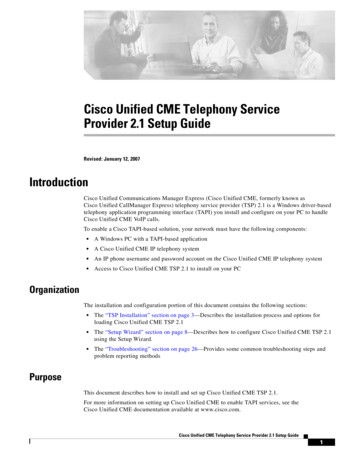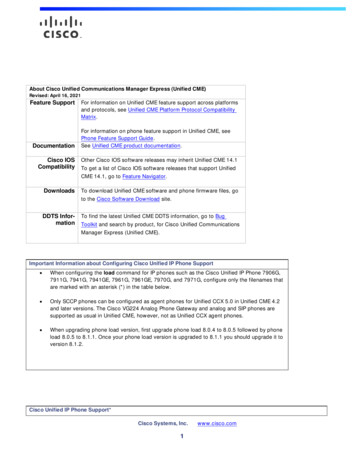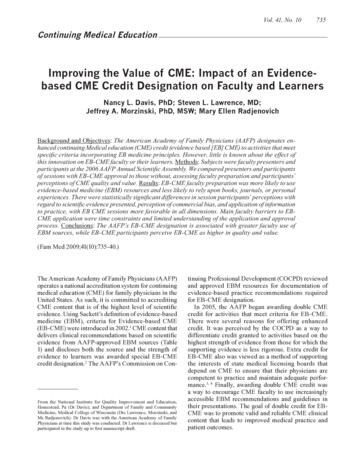
Transcription
Vol. 41, No. 10735Continuing Medical EducationImproving the Value of CME: Impact of an Evidencebased CME Credit Designation on Faculty and LearnersNancy L. Davis, PhD; Steven L. Lawrence, MD;Jeffrey A. Morzinski, PhD, MSW; Mary Ellen RadjenovichBackground and Objectives: The American Academy of Family Physicians (AAFP) designates enhanced continuing Medical education (CME) credit (evidence based [EB] CME) to activities that meetspecific criteria incorporating EB medicine principles. However, little is known about the effect ofthis innovation on EB-CME faculty or their learners. Methods: Subjects were faculty presenters andparticipants at the 2006 AAFP Annual Scientific Assembly. We compared presenters and participantsof sessions with EB-CME approval to those without, assessing faculty preparation and participants’perceptions of CME quality and value. Results: EB-CME faculty preparation was more likely to useevidence-based medicine (EBM) resources and less likely to rely upon books, journals, or personalexperiences. There were statistically significant differences in session participants’ perceptions withregard to scientific evidence presented, perception of commercial bias, and application of informationto practice, with EB CME sessions more favorable in all dimensions. Main faculty barriers to EBCME application were time constraints and limited understanding of the application and approvalprocess. Conclusions: The AAFP’s EB-CME designation is associated with greater faculty use ofEBM sources, while EB-CME participants perceive EB-CME as higher in quality and value.(Fam Med 2009;41(10):735-40.)The American Academy of Family Physicians (AAFP)operates a national accreditation system for continuingmedical education (CME) for family physicians in theUnited States. As such, it is committed to accreditingCME content that is of the highest level of scientificevidence. Using Sackett’s definition of evidence-basedmedicine (EBM), criteria for Evidence-based CME(EB-CME) were introduced in 2002.1 CME content thatdelivers clinical recommendations based on scientificevidence from AAFP-approved EBM sources (Table1) and discloses both the source and the strength ofevidence to learners was awarded special EB-CMEcredit designation.2 The AAFP’s Commission on Con-From the National Institute for Quality Improvement and Education,Homestead, Pa (Dr Davis); and Department of Family and CommunityMedicine, Medical College of Wisconsin (Drs Lawrence, Morzinski, andMs Radjenovich). Dr Davis was with the American Academy of FamilyPhysicians at time this study was conducted. Dr Lawrence is deceased butparticipated in the study up to first manuscript draft.tinuing Professional Development (COCPD) reviewedand approved EBM resources for documentation ofevidence-based practice recommendations requiredfor EB-CME designation.In 2005, the AAFP began awarding double CMEcredit for activities that meet criteria for EB-CME.There were several reasons for offering enhancedcredit. It was perceived by the COCPD as a way todifferentiate credit granted to activities based on thehighest strength of evidence from those for which thesupporting evidence is less rigorous. Extra credit forEB-CME also was viewed as a method of supportingthe interests of state medical licensing boards thatdepend on CME to ensure that their physicians arecompetent to practice and maintain adequate performance.3, 4 Finally, awarding double CME credit wasa way to encourage CME faculty to use increasinglyaccessible EBM recommendations and guidelines intheir presentations. The goal of double credit for EBCME was to promote valid and reliable CME clinicalcontent that leads to improved medical practice andpatient outcomes.
736November-December 2009Table 1AAFP-approved EBM Sources in 2006American College of Physicians’ (ACP) Physicians’ Information andEducation Resources (PIER)Agency for Healthcare Research and Quality (AHRQ)BandolierCanadian Task Force on Preventive Health CareClinical EvidenceCochrane Database of Systematic ReviewsDatabase of Abstracts of Reviews of Effects (DARE)DynaMedTMEBM OnlineEffective Health CareInstitute for Clinical Systems Improvement (ICSI)InfoRetrieverTMNational Guidelines ClearinghousePEPIDTMUpToDateTMUS Preventative Services Task Force (USPSTF)AAFP—American Academy of Family PhysiciansEBM—Evidence-based MedicineActivities are designated for EB-CME credit whenCME providers submit a special application to theAAFP. CME faculty must document in that application that they will present evidence-based practicerecommendations that are verifiable in preapprovedEBM sources. The COCPD reviewed the CME activityapplications and approved EB-CME credit designation.Since EBM only applies to clinical topics, non-clinicaltopics were not eligible for EB-CME credit.There was criticism from CME faculty and providers that the process for designating EB-CME is difficult and onerous, and many refused to complete thenecessary application forms and other documentationnecessary to designate their activities as EB-CME.5Additionally, many learners had failed to appreciate thevalue of EB-CME prior to the awarding of double CMEcredit. Awarding of double credit, however, stimulatedphysician interest in EB-CME designated activities.The present research, which was preceded by preliminary study reported elsewhere,6 responded to calls toreexamine methods of establishing CME credit andincreasing the rigor of CME.7 We studied the differences between CME faculty who submitted their presentations for AAFP EB-CME credit and those who didnot. Specifically, the study had three main purposes: (1)determine the types of resources used and preferencesfor EBM resources to prepare CME presentations, (2)Family Medicineidentify barriers to preparing EB-CME application,and (3) identify learners’ perceived differences in CMEsessions designated as EB-CME versus those that arenot. The study was granted an exemption from formalreview by the AAFP Institutional Review Board.MethodsSubjects and SettingThe 2006 AAFP Scientific Assembly (hereafter referred to as “Assembly”) was held in September 2006in Washington, DC. More than 4,800 family physiciansattended 351 total CME activities during the 5-dayAssembly.FacultyFifty faculty presenters were randomly selected fromthe 96 EB-CME designated sessions and all facultyfrom the 19 eligible non-EB-CME designated clinicalsessions at the Assembly were selected to receive ane-mail inviting them to voluntarily participate in thestudy. The total sample thus consisted of 69 facultymembers.While the Assembly included 255 total non-EB-CMEdesignated sessions, only 19 of those addressed clinical topics. The others addressed practice management,research methods, or technology topics. Since nonclinical topics do not have clinical evidence to supportthem they are not eligible for EB-CME credit.Physician AttendeesPhysicians who participated in the AAFP ScientificAssembly learning activities were a second populationof interest. Subjects for this phase of data collectionwere learners in 20 of the sessions taught by EB-CMEfaculty, and all 19 non-EB-CME designated clinicalsessions, for a total of 39 sessions. The number ofEB-CME sessions was selected purposively based onavailability of staff members who had been recruitedto assist with the study as part of their conference management duties. It was limited to the 20 sessions withhighest attendance, thus ensuring most reliable staffing.For each of the 39 sessions sampled, staff randomlyselected 20 participants as they entered the room andasked them to complete the learner survey.Instruments/ProceduresThose faculty selected to participate were e-mailed asurvey immediately following the Assembly with up tothree follow-up e-mail reminders and instructions forreturning the completed survey to designated AAFPAssembly staff members (staff not on the researchteam). Identifiers were removed before completedsurveys were sent to the study coordinator for dataentry.
Continuing Medical EducationVol. 41, No. 10Faculty SurveyThe instrument was based on the previously pilottested survey.6 In that prior study, a five–item instrument asked faculty to report the various resources usedto prepare their CME presentation and the percentageof their total preparation attributed to each resource.Choices included the speaker’s own practice, consultingwith colleagues, presentations from other professionalmeetings, textbooks, journals and other print media,Web-based resources, or others they were allowed tospecify. In the present study, we expanded the choicesto include specific AAFP-approved EBM sources presented in a checklist. Faculty in the EB-CME subgroup(n 50) were asked to report time spent researching forapproved EBM documentation and time spent with theEB-CME application process. Those who presentedclinical topics but who did not seek EB-CME designation (n 19) were asked to list barriers to seekingEB-CME credit. We also asked for demographic data,included gender, age, and practice category, eitheracademic or nonacademic.Attendee SurveyCME participants were presented surveys as theyentered the session; the surveys were collected at thedoor as they left the room. No identifiers were used inthe instrument. These survey items included a requestthat subjects rank reasons for choosing the session (eg,topic, time of session, evidence-based approach, number of credits, and perception of speaker reputation).A second set of questions used a 5-point Likert-typeresponse scale (1 strongly disagree, 5 strongly agree).Table 211420312912Non–EB-CME Faculty(n 13)**68% Response RateAgeLess than 3536–4546–5556–6465 or morePractice SettingAcademicNon-academicSubjects assessed the degree to which the session wasbased on valid scientific evidence, the speaker had agood understanding of the clinical evidence presented,the session was commercially biased, and to what degree the participant would apply new information topatients and/or practice.Data AnalysisDemographic information, percentages and item countswere noted. The nonparametric Mann-Whitney test wasused to analyze ordinal data from the Likert-type itemsthat compared participant perceptions.8 All data wereanalyzed by session type but not by individual session.ResultsCME FacultyOf the 50 EB-CME session faculty surveyed, 41(82%) responded, and of the 19 non-EB-CME sessionfaculty, 13 (68%) responded. The majority in bothgroups were male (82% and 92% respectively). Age distribution and practice setting are shown in Table 2.Faculty responses to questions about the resourcesused in preparing their CME activity are shown in Table3. The most used resources by EB-CME faculty were“my own medical practice” (25.4%), AAFP approveEBM sources (25.4%), and Web-based searches (21.1%).Non-EB CME faculty most often used “textbooks,CDs, tapes, paper journals” (32.3%), their own medicalpractice (30.4%), and Web searches (14.2%) as resourcesfor preparing their presentations. Non-EB-CME facultyreported using AAFP-approved EBM sources for anaverage of 6.9% of their preparation resources for theirTable 3Demographics of EB-CME and Non-EB-CMEFaculty RespondentsEB-CME Faculty(n 41)*82% Response RateAgeLess than 3536–4546–5556–6465 or morePractice SettingAcademicNon-academic737Sources Used by Faculty to PrepareCME Presentation2190185EB-CME—Evidence-based continuing medical education* EB-CME faculty were those whose presentations were approved fordouble credit.** Non-EB CME faculty were those whose presentations were notapproved, or those who did not apply, for double-credit.SourceMy own practice experienceAAFP-approved EBM sourcesWeb-based searches, eg, PubMedTextbooks, CDs, journalsPresentations from professional meetingsConsult with colleagues/expertsOther*EB-CMEFaculty(n 41)25.4%25.4%21.0%14.9%6.9%6.2% 1%Non-EBCMEFaculty(n 13)30.4%6.9%14.2%32.3%3.5%8.8%3.9%** Other resources cited were ABFM, evidence-based practice, MD consultWeb searchAAFP—American Academy of Family PhysiciansEBM—Evidence-based medicineEB-CME—Evidence-based Continuing Medical Education
738November-December 2009Family MedicineCME activity. Both groups also reported using consultswith colleagues and professional meeting presentations;“other” sources specified by respondents includedAmerican Board of Family Medicine, American HeartAssociation, American College of Cardiology, GoogleAdvanced Search, Evidence Based Practice, and MDConsult (Table 3).When asked to indicate all AAFP-approved sourcesused in their preparation, the most frequently citedsources were the Cochrane Library, US PreventativeServices Task Force, and National Guidelines Clearinghouse databases. EB-CME faculty tended to usemultiple evidence-based sources (an average of threeper faculty member) while non-EB-CME faculty tendedto use a single source (Table 4).When faculty who chose not to apply for EB-CMEcredit for their sessions were asked to list barriers thatTable 4Faculty Members Use of AAFP-approved EBMSources to Prepare CME PresentationEB-CMEFaculty(n 41)0Non-EB-CMEFaculty(n 13)0AHRQ182Bandolier15030Clinical Evidence91Cochrane Library314DARE41DynaMedTM51EBM Online21Effective Health Care10ICSI40InfoRetrieverTM6125201UpToDateTM142US Preventative Services Task Force25531AAFP-approved EBM SourceACP PIERCanadian Task ForceNational Guidelines ClearinghousePEPIDTMMean number of sources per facultyAAFP—American Academy of Family PhysiciansEBM—Evidence-based medicineEB-CME—Evidence-based Continuing Medical EducationACP PIER—American College of Physicians’ Physicians’ Informationand Education ResourceAHRQ—Agency for Healthcare Research and QualityDARE—Database of Abstracts and Reviews of EffectivenessEBM Online—Evidence-based Medicine OnlineISCI—Institute for Clinical Systems ImprovementPEPID—Portable Emergency and Primary Care Information Databaseled to their decision, the reasons most often cited weretime constraints and lack of scientific evidence for theclinical area they presented. One respondent cited alack of understanding of the AAFP’s EB-CME application process, and another listed cost for use of someapproved sources as an obstacle. The average amountof additional time required for the EB-CME application was reported to be 8 hours for the faculty withoutassistants. Those faculty using assistants reported anaverage of 2 hours of their own time researching sourcesand an average of 2.6 hours of assistants’ time. Averagetime reported for completing documentation requiredby AAFP was 1.5 hours for faculty without assistance.Those using an assistant spent an average of 1 hour, andassistants spent an average of .6 hours (36 minutes) tocomplete documentation requirements.AttendeesA total of 514 participant surveys were returned, 281from EB-CME sessions and 233 from non-EB-CMEsessions. The overall top-ranked reason to attend asession was “topic” followed by “time of session” and“evidence-based approach.” “Speaker reputation” and“number of credits” respectively were ranked lowest asmotivators for attendance. When choices were analyzedby the session’s EB-CME status, the findings remainedconsistent with overall rankings.Responses to those questions that asked participantsto rate characteristics of the session, with comparisonsof EB-CME approved or non-approved CME, areshown in Table 5. Participant ratings were significantlymore positive in three of these comparisons: basedon valid scientific evidence (4.04 compared to 3.81),perceived commercial bias (1.39 compared to 1.57, thelower rating was better for this item), and new information will be applied to practice (4.37 for EB and 4.02for non-EB sessions). The fourth comparison, speakerunderstood evidence, was more positive for EB sessions (4.66 compared to 4.53), but the difference wasnot statistically significant (P .05).DiscussionThis study is the first to examine the behavior andopinions related to EB-CME for faculty and learners.We were able to replicate the findings of the smaller,regional study with regard to sources used by faculty inpreparing their CME content. Distributions were similar, with EB faculty most often citing their own practices, EBM sources, and on-line searching as sources ofinformation, while non-EB faculty relied more heavilyon their own professional experiences along with books,journals, and CDs. We could not compare the use ofspecific AAFP-approved evidence-based sources sinceour earlier study did not examine that.The AAFP EB-CME initiative was developed tostimulate the development and delivery of CME at the
Continuing Medical EducationVol. 41, No. 10739Table 5Participants’ Perceptions of Evidence, Bias, and Practice ApplicationMeasureSession based on valid scientific evidenceSpeaker understood evidencePerceived commercial biasNew information will be applied to practiceEB-CME Sessions (n 20)Mean Rating4.044.661.394.37Non-EB CME Sessions (n 19)Mean Rating3.814.531.574.02Significance *(P .05).02*.09.01*.00*Session participants in 20 EB-CME sessions (n 281) and 19 non-EB-CME sessions (n 233), rated the four variables shown using a 5-point Likerttype response scale where 1 strongly disagree, 5 strongly agree. The Mann-Whitney non-parametric test was used to determine statistical significance(P .05).highest strength of scientific evidence. When CMEpresenters use EBM Web sources, there is a greaterlikelihood that their teaching will reflect current practice recommendations and improve the recommendedalignment of CME with practice guidelines.8 The factthat an overwhelming majority of AAFP Assemblyclinical faculty sought and received EB-CME credit fortheir sessions indicates the value placed on EB-CMEcredit by AAFP and their faculty.The requirement to use AAFP-approved EBM sources seems to have had the desired effect with the EBCME faculty reporting use of those sources three timesmore than their non-EB faculty colleagues. Those whouse EBM sources seem much less likely to rely on theirown practice experience to prepare CME content. Thepreference for the Cochrane Library, National Guideline Clearinghouse, US Preventive Services Task Force,AHRQ, and one commercial product, UpToDateTM, mayspeak to their availability to family physicians. Knowing these preferences will be useful to CME providersas they work with faculty to develop CME for familyphysicians and other primary care clinicians.The primary barriers to applying for EB-CME creditin this study, as well as the regional study, were timeconstraints and lack of evidence in a particular clinicalarea. As faculty become more attuned to evidencebased approaches, they will likely be more efficientin searching and seeking out evidence-based content.The AAFP should continue to refine their processesto increase efficiency in the application process. Therewill always be some additional work to document thisspecial credit designation. The lack of clinical evidencewill mean that there are always some CME presentations that will not meet the criteria for EB-CME. Theprocess will stimulate faculty to start their contentpreparation by looking at available evidence and usingvalidated EBM sources to ensure that practice recommendations are based on best available evidence aswell as their own knowledge and clinical experience.Learners have more assurance that their CME is evidence based and without commercial bias.This study also seems to show physician learnersplace value on EB-CME even if they didn’t use thedesignation as the main reason to attend a session.Markers for high-quality CME, scientific evidence,and lack of commercial bias were rated higher in theEB-CME sessions, and participants were more positiveabout applying new knowledge to practice.LimitationsThis study had a number of limitations. First, the relatively low number of clinical sessions available withoutEB-CME led to fewer than desired non-EB-CME faculty participants to include in the study. Because theAAFP emphasizes the importance of EB-CME credit, itmay have a higher percentage of EB-CME sessions thanother CME programs. Second, selection of sessionsused to study participants was based on availability ofconference staff, rather than a true random selection,but given the population and sample size, we don’tbelieve this influenced the results. Third, simple useof the term “AAFP-approved evidence-based sources”may have influenced both faculty and learners in theirbehaviors and responses.ConclusionsBased on this study, we recommend continuedemphasis on the use of EBM sources for CME development. Implementing the AAFP’s criteria forevidence-based CME will help to ensure a higher levelof evidence and less risk of perceived commercial biasin CME.Acknowledgments: In-kind only funding was received from the AmericanAcademy of Family Physicians and the Medical College of Wisconsin.An abstract of methods and preliminary data was presented at the May2008 CME Congress in Vancouver.
740November-December 2009Corresponding Author: Address correspondence to Dr Davis, NationalInstitute for Quality Improvement and Education, 285 Waterfront DriveEast, Suite 100, Homestead, PA 15120. 412-205-5368. Fax: 412-202-1667.ndavis@niqie.org.References1. Sackett DL, Straus SE, Richardson WS, et al. Evidence-based medicine:how to practice and teach EBM, second edition. London: ChurchillLivingstone, 2000.2. American Academy of Family Physicians. EB-CME guidelines anddocumentation. cessed March 23, 2008.3. Johnson DA, Austin DL, Thompson JN. Role of state medicalboards in continuing medical education. J Contin Educ Health Prof2005;25:183-9.Family Medicine4. Williams BW. The prevalence and special educational requirements of dyscompetent physicians. J Contin Educ Health Prof 2006;26:173-91.5. Davis NL. Evidence-based CME: its time has come. The STFM Messenger 2003;Dec:2.6. Lawrence SL, Morzinski JA, Radjenovich ME. The influence of doublecredit evidence-based continuing medical education on presenters andlearners. Wisc Med J 2008;107(4):181-6.7. Davis NL, Willis CE. A new metric for continuing medical educationcredit. J Cont Educ Health Prof 2004;24:139-44.8. SPSS base applications guide. Chicago: SPSS, Inc, 19999. Zieger RF. Toward continuous medical education. J Gen Intern Med2004;20:91-4.
mance.3, 4 Finally, awarding double CME credit was a way to encourage CME faculty to use increasingly accessible EBM recommendations and guidelines in their presentations. The goal of double credit for EB- CME was to promote valid and reliable CME clinical content that leads to improved medical practice and patient outcomes.


